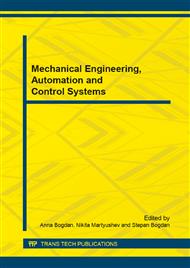[1]
G.I. Marchuk, Mathematical Models in Environmental Problems. Nauka, Moscow, 1982, 319 p.
Google Scholar
[2]
A.A. Samarskii and P.N. Vabishevich, Numerical Methods for Inverse Problems in Mathematical Physics, Editorial URSS, Moscow, (2004).
Google Scholar
[3]
G.V. Alekseev and D.A. Tereshko, Analysis and optimization in viscous fluid hydrodynamics, Dal'nauka, (2008).
Google Scholar
[4]
M. D. Gunzburger, L. Hou, and T. P. Svobodny, The Approximation of Boundary Control Problems for Fluid Flows with an Application to Control by Heating and Cooling, Comput. Fluids 22 (1993) 239–251.
DOI: 10.1016/0045-7930(93)90056-f
Google Scholar
[5]
K. Ito and S. S. Ravindran, Optimal Control of Thermally Convected Fluid Flows, SIAM J. Sci. Comput. 19 (1998) 1847–1869.
DOI: 10.1137/s1064827596299731
Google Scholar
[6]
G. V. Alekseev, Solvability of Stationary Boundary Control Problems for Thermal Convection Equations, Sib. Mat. Zh. 39 (1998) 982–998.
DOI: 10.1007/bf02672906
Google Scholar
[7]
H. C. Lee and O. Yu. Imanuvilov, Analysis of Optimal Control Problems for the 2D Stationary Boussinesq Equations, J. Math. Anal. Appl. 242 (2000) 191–211.
DOI: 10.1006/jmaa.1999.6651
Google Scholar
[8]
H. C. Lee, Analysis and Computational Methods of Dirichlet Boundary Optimal Control Problems for 2D Boussinesq Equations, Adv. Comput. Math. 19 (2003) 255–275.
Google Scholar
[9]
G. V. Alekseev, Inverse Extremum Problems for Stationary Heat Convection Equations, Vestn. Novosibirsk. Univ., Ser. Mat. 6, 2 (2006) 7–31.
Google Scholar
[10]
G. V. Alekseev, Coefficient Inverse Extremum Problems for Stationary Heat and Mass Transfer Equations, Comput. Math. Math. Phys. 47 (2007) 1007–1028.
DOI: 10.1134/s0965542507060115
Google Scholar
[11]
G. V. Alekseev, O. V. Soboleva, and D. A. Tereshko, Identification Problems for a Steady Mass Transfer Model, Prikl. Mekh. Tekh. Fiz. 49, 4 (2008) 24–35.
Google Scholar
[12]
H. C. Lee, Optimal Control Problems for the Two Dimensional Rayleigh–Benard Type Convection by a Gradient Method, Jpn. J. Ind. Appl. Math. 26, 1 (2010) 93–121.
DOI: 10.1007/bf03167547
Google Scholar
[13]
G. V. Alekseev and D. A. Tereshko, Boundary Control Problems for Stationary Equations of Heat Transfer, Advances of Mathematical Fluid Mechanics (Birkhдuser, Basel, 2009), p.1–21.
DOI: 10.1007/978-3-0346-0152-8_1
Google Scholar
[14]
G. V. Alekseev and D. A. Tereshko, Extremum Problems of Boundary Control for a Stationary Thermal Convection Model, Dokl. Math. 81 (2010) 151–155.
DOI: 10.1134/s1064562410010412
Google Scholar
[15]
G. V. Alekseev and D. A. Tereshko, Extremum Problems of Boundary Control for Stationary Thermal Convection Equations, Prikl. Mekh. Tekh. Fiz. 51, 4 (2010) 72–84.
Google Scholar
[16]
G. V. Alekseev, I. S. Vakhitov, O. V. Soboleva, Stability estimates in problems of identification for the equation convections-diffusions-reactions, Computational Mathematics and Mathematical Physics. 52 (2012) 1635-1649.
DOI: 10.1134/s0965542512120032
Google Scholar
[17]
Ju. Ya. Fershalov, T.V. Sazonov, Experimental Research of the Nozzles, Advanced Material Research. 915–916 (2014) 345.
DOI: 10.4028/www.scientific.net/amr.915-916.345
Google Scholar
[18]
M. Yu. Fershalov, A. Yu. Fershalov, Yu. Ya. Fershalov Calculation of reactivity degree for axial lowaccount turbines with small emergence angles on nozzle devices. Advanced material research vol. 915-916 (2014), 341.
DOI: 10.4028/www.scientific.net/amr.915-916.341
Google Scholar
[19]
Yu. Ya. Fershalov, Technique for physical simulation of gasodynamic processes in the turbomashine flow passages, Russian Aeronautics. 55 (2012) 424-429.
DOI: 10.3103/s1068799812040186
Google Scholar


